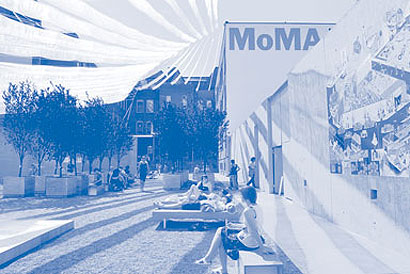|
Alice Twemlow chairs the design criticism course at New York’s school of visual arts and has been a guest critic at Yale and Risd. She has written for Eye, Grafik and Design Observer.
Peter Zumthor pavilion, Serpentine Gallery, London (top image)
I approached the severe-looking timber box expecting nothing more than a moment’s contemplation of the interplay of textured architectural surfaces. Instead, as I came out of the darkness of the perimeter corridor into the inner chamber, I was met by a tableau of leaves, grasses, and flowers, planted down the centre of the structure (by garden designer Piet Oudolf). Rain poured on to the plants and dripped off the edge of the overhang under which I sat looking and looking.
Superscript book club, New York
This was a book club, open to the public, that met on the High Line. The book discussed was The Social Life of Small Urban Spaces, William Whyte’s classic 1980 study of New York’s plazas, led by featured critic Alexandra Lange. The book club was an excellent example of how to engage the public in design discourse. Discussion was rich enough to sustain the interest of professionals but approachable enough that passersby picked up the photocopied extracts and joined us.

credit NY Times
Peter Schjeldahl’s 4 July Fireworks Display, New York State
Each 4 July, New Yorker art critic Peter Schjeldahl stages a fireworks display in the Western Catskill Mountains. Once dark, Schjeldahl lets loose his choreographed 20-minute barrage on the senses. Amid the smoke rising, you catch glimpses of helpers crawling through the grasses to light the next batch of explosives. There’s a story of a woman whose hair once caught alight. The balance between the extravaganza’s terror and beauty is what lifts it to the level of cultural practice.

credit Alice Twemlow
Tape Generations, Johan Rijpma
Dutch artist Johan Rijpma spent six months creating this study of dancing tape rolls. In the opening sequence the artist’s hand affixes a role of tape to the underside of a circular table. As the tape unfurls, its progress is captured through a mixture of stop frame and continuous action. The rest of the film depicts the unravelling of multiple tape rolls gathered in different symmetrical circular patterns. A delightful homespun live-action animation that I can’t stop watching.

credit John Rijpma
Holding Pattern, Interboro partners, MoMA PS1, New York
Every summer MoMA PS1 holds events in its courtyard and conducts a competition to find an architect to design the space. This year’s winners, Brooklyn-based Interboro Partners, designed Holding Pattern which featured ping-pong tables, a lifeguard chair, a rock-climbing wall and 84 trees. The designers canvassed local libraries, schools, care centers and community gardens to find out what they needed and transplanted these items to MoMA PS1’s courtyard until the show was taken down when items were distributed accordingly.

credit John Offenbach
Euro Crisis interactive graphics, New York Times
This crisp piece of information graphics, available in print and as a series of interactive charts, brings clarity and depth to the debt crisis in Europe. Bill Marsh’s Data Points in the New York Times represent a hybrid of journalism and graphic design that enables the reader to grasp a complicated news topic through well-considered visuals, but also to drill down into details through the sidebars, labels and links to related documents and sites. The future direction of news reporting.

credit Howard Heyman
|
|
Image
Ellen Datlow
Words
Alice Twemlow
|



















